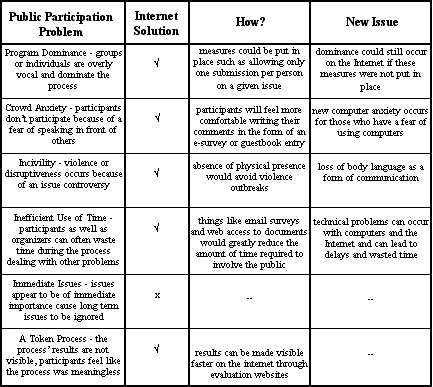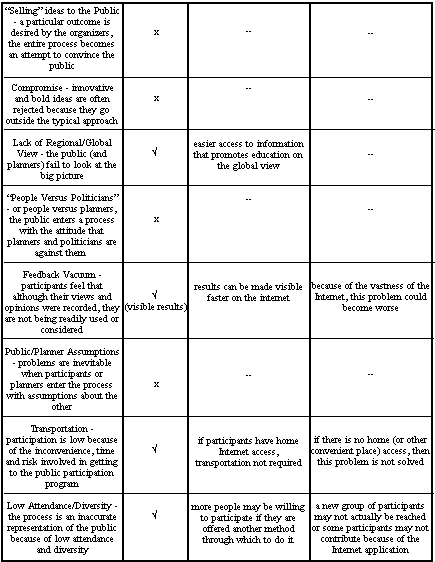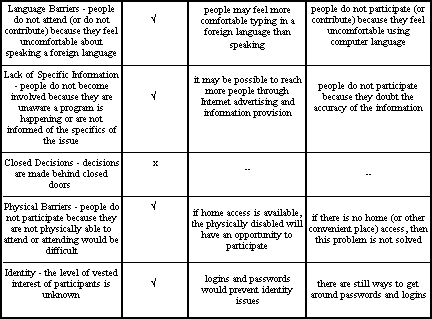


5.0 Specifics - WHAT?
The specifics of what "Internet applications" might
be must be determined. This involves an analysis of what is needed
and required for the Internet application to be successful and
then determining if the current technology can provide or if it
is anticipated that it soon will.
5.1 Applications
Internet public participation applications can include an array
of devices.
General Websites
Websites
are a simple and effective way to provide information. Whether
documents are uploaded directly to the website or they are downloadable
files, having documents of relating topic compiled on a website
is useful form of initial public education. Websites containing
useful databases as well as various group listings,would make
it easier to match needs with resources.
As technology advances and bandwidths increase, the possibilities for audio and video file downloads will increase website capabilities, for example: relevant presentations (audio, video or software such as PowerPoint) downloadable from a website.
E-surveys
E-surveys are an electronic version of the traditional survey.
If properly advertised and designed, they can greatly improve
on the amount of time it takes to conduct a traditional survey.
E-surveys can also be embedded directly into a website so that
people who visit the website will have the option of answering
the survey on the Web. This allows the public to think about and
respond to issues with the reference material at hand.
There are several online companies that offer free survey services. Not only do the provide the HTML to put on the desired website but they also provide users with the tallied information that has come in via the survey.
Guestbooks/Bulletin
Boards
Unlike e-surveys,
which have a structured set of questions, guestbooks or bulletin
boards ask for general comments and feedback on a given topic
or document. They also provide a place for posting questions or
suggestions
Community Email
Listservers
Email listservers are an effective way to keep individuals connected
and up-to-date on a given issue. They can me created and maintained
easily. There are many online companies offering free email listserver
services such as Listbot and Egroups. Because listservers are
centred around a particular topic or community, the provide an
efficient place to post questions by increasing the probability
of locating someone who knows the answer.
Listservers can be created to address a particular issue and then changed as the issues of the community change. Titles and options are easily altered; lists can be open or restricted to membership, moderated or unmoderated, digested (several emails sent at once) or undigested.
Newsgroups
Like email
listservers, newsgroups offer an effective way for communities
to stay connected and informed. They can be set up for particular
discussions. Past discussions can also be accessed easily after
the discussion has taken place.
Electronic Charettes
The charette
is a method that could include an Internet application. A charette
is like a brainstorming session. Community members come together
to propose a solution to a defined problem or issue in a very
short period of time (usually 24 hours). The process consists
of: the issue or problem is presented along with any other needed
background information, groups or teams are formed, groups work
on their proposals, proposals are presented to the rest of the
groups, the best is voted on.
The Internet could come into play in many areas of the charette. All background information and issue identification would be posted online. Organizational information as well as information about the teams participating would too be available online. Teams would work face-to-face or, if they were familiar with the technology, online. Reports would be compiled and uploaded to a website. The other teams would view and then vote online and the winning idea would be posted.
Internet Relay
Chats
The Internet
relay chat provides a place realtime discussion. Although there
is no visual interaction, discussion can happen through a provided
window and a keyboard. Chat rooms, like the listservers and websites,
can be created for a specific issue or topic and used for a specified
discussion. They can provide a venue for discussion for those
who may be restricted in some way from attending the face-to-face
meetings. Future technologies and accessibility to them may prove
to eliminate the non-visual factor of IRC.
Community Internet
Networks
A community
Internet network is collection of some (or all) of the above mentioned
applications with a very defined role. It is created to connect
a specific community by that community. It could include a website,
a listserver, a newsgroup, etc. To accommodate those without an
Internet connection (or computer), a group of networked computers
would be set up in a facility central to the community, such as
a community centre or library. Community networks give people
a place to share and work together, whether physically or virtually.
Section 3.4 identifies several predictions for the Internet and related communications technology. These will of course impact the future of using the Internet as a public participation tool. Connecting the technologies of the television, telephone and facsimile with that of the Internet, advancing to wireless connections, and overall improvements in ease of use will begin to open up even more possibilities for participating online.
5.2 Access
Access is a big issue when discussing the Internet. To keep the
process entirely public, there must be access for the entire public.
Therefore it is recommended that public Internet connections be
emphasized.
Library Terminals
Public libraries
represent the place of knowledge in the community. They are open
and accessible by all community members. Having several Internet
connected computers in the public library would increase access
to those who do not have access at home.
It would also increase public participation to have several of the computers designated as "Public Participation Computers" in that they would have software and tools that would be useful for Internet public participation applications including clear and easy-to-use webpage design software, word processing software, and web browsers. These designated computers would also be equipped with search engines for the library as well as local university libraries. The web browser would include an extensive set of public participation related bookmarks. These computers would be understood to be the tools used when community members wish to become involved.
University Terminals
These terminals
would be similar to the public library terminals. They would be
accessible to all members of the public as well as being tied
directly to public libraries and the sources of information in
the university. However, having them on a university campus, their
use could be extended through means such as connecting them with
a particular course or workshop within the ciriculum of the university.
Students studying planning, public management, law, sociology
or any number of subjects would be responsible for maintaining
the terminals.
Community Centres
Community
centres are places accessible to the entire community. As mentioned
in section 6.1, groups of networked computers would be placed
in community centres to offer a public place to use the Internet
and develop community networks.
Internet Kiosks
The other
three access ideas tie the Internet connection to a specific place.
Internet kiosks would remove Internet connections from libraries
or universities and put them in random locations throughout the
community. This would be used if the community had neither a library
nor a university close by. These kiosks would be placed in any
public area and designated, as in the other two locations, as
"Internet Public Participation Zones".
5.3 Design
When a device,
machine or object is fumbled over, the blame is usually laid on
the user. They are clumsy, uneducated, untrained. Rarely is the
object blamed. However, it is often the poor design of the machine
in use that is causing the problems. This is often the case when
the Internet is being used. People "get lost" or confused
when surfing the Web and blame their inexperience. The culprit
is often bad web design. (Norman 1990: xi)
Internet public participation websites should be clear, simple, and easy to use. Good navigation is crucial. The Internet application is public and must be usable by everyone, even those who have little or no experience. Obvious signals should be present to let the user now where they are within the site. How the site works should be implicitly designed into it (Norman 1990: 4).
A commonly understood theory in public website design is "designing for the lowest common denominator". This refers to designing websites and other Internet services so that those with the oldest modems and lowest levels of memory can still access them as readily as those with more advanced faster computers. This is a concern with designing an Internet public participation program. The design must be simple, small in size, easy to use, and compatible (with both Mac and IBM). However, interest, enthusiasm, and energy must not be lost in this assurance of accessible design.
5.4 Ownership
Ownership is
a major issue. If the government is in control of the public participation
program won't the same problems that have risen out of traditional
programs also come out in an Internet version? There are several
options for ownership.
Government
There is
concern that government ownership would lead to some of the same
problems that currently exist with traditional public participation
programs. The government may begin to apply some of their typically
bureaucratic ways of doing things to an Internet version of public
participation which would lead to access and efficiency problems.
Non-government
Organizations
Non-government
organizations (NGO's) are often much more productive than government
organizations, even when they are government funded. NGO's are
grassroots types of organizations, they rise out of the community
recognizing their own needs. They include non-profit organizations
and usually rely heavily on volunteerism. NGO's would eliminate
much of the government bureaucracy associated with current public
participation. They may also lead to increased involvement and
contribution as the public sees their disassociation with the
government.
Community Groups
An entirely
community owned, run, and funded Internet application would be
another option for ownership. This type of ownership would be
totally free from any government restriction whatsoever. Community
groups could create and run their Internet communities using free
online services and perhaps neighbourhood fund raising.


